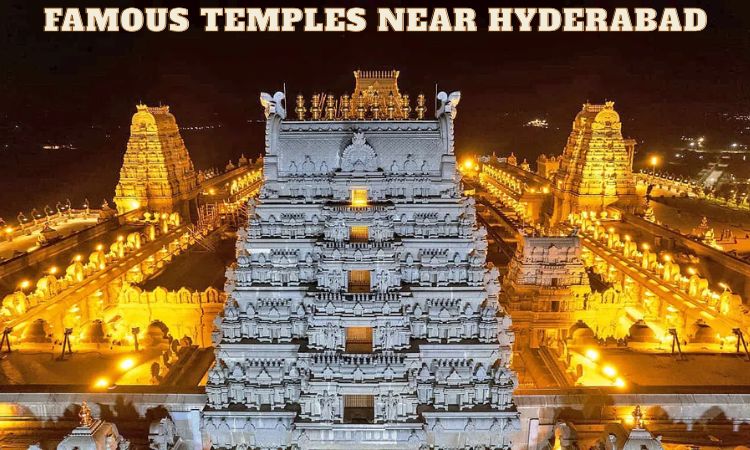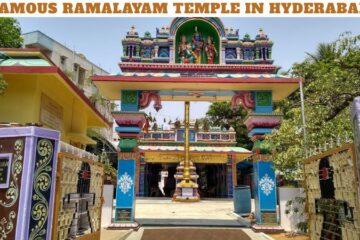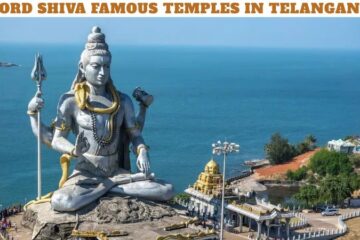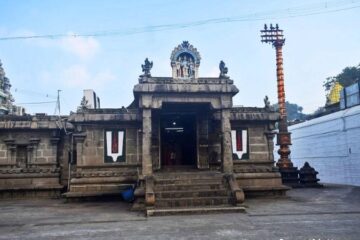
Table of Contents
Hyderabad, the bustling capital of Telangana, is not only a hub of technology and culture but also a gateway to a myriad of ancient and revered temples that dot its surrounding landscapes. For devotees, history enthusiasts, and curious travelers alike, a journey to these famous temples near Hyderabad offers a profound glimpse into the region’s spiritual heritage, architectural prowess, and enduring traditions. Each temple tells a unique story, steeped in mythology, devotion, and centuries of worship, making them essential stops for anyone seeking solace, blessings, or a deeper understanding of South Indian spirituality.
Yadagirigutta (Yadadri Lakshmi Narasimha Swamy Temple): The Abode of Narasimha
Approximately 60 kilometers from Hyderabad, perched atop a scenic hill, lies the magnificent Yadagirigutta, now officially known as Yadadri. This temple is dedicated to Lord Lakshmi Narasimha Swamy, an incarnation of Lord Vishnu. The legend states that Lord Narasimha appeared in five different forms (Jwala Narasimha, Yogananda Narasimha, Gandabherunda Narasimha, Ugra Narasimha, and Lakshmi Narasimha) to a sage named Yada Maharshi, who performed penance here.
The temple has recently undergone a massive renovation, transforming it into a stunning architectural marvel. The entire temple complex is carved out of black granite, giving it a unique and imposing appearance. The intricate carvings, gopurams (towering gateways), and the sanctum sanctorum reflect the grandeur of traditional South Indian temple architecture. The main deity, a self-manifested (Swayambhu) idol of Lord Narasimha, is housed in a cave within the hill. Devotees believe that visiting Yadadri can alleviate mental and physical ailments and fulfill wishes. The serene atmosphere, coupled with the breathtaking views from the hilltop, makes it a truly divine experience. The temple attracts millions of devotees, especially during Brahmotsavams and other major festivals.
Bhadrachalam Temple: The Ayodhya of the South
Situated on the banks of the sacred River Godavari, about 310 kilometers from Hyderabad, is the renowned Bhadrachalam Temple, dedicated to Lord Rama. Often referred to as “Dakshina Ayodhya” (Southern Ayodhya), this temple holds immense significance for Ram Bhakts. The temple’s history is closely associated with Bhakta Ramadasu, a 17th-century devotee who built the temple with his own funds and even faced imprisonment for using state revenue for its construction. Lord Rama, along with Sita and Lakshmana, is the presiding deity here.
The architecture of the temple is a blend of various styles, reflecting its long history and multiple renovations. The main idols are believed to be self-manifested. The temple town comes alive during the annual Sri Rama Navami festival, which celebrates the birth of Lord Rama, and the Kalyanam (celestial wedding) of Lord Rama and Sita. A dip in the Godavari river before visiting the temple is considered highly auspicious. The spiritual aura of Bhadrachalam, combined with its scenic riverside location, offers a deeply moving pilgrimage experience.
Chilkur Balaji Temple: The Visa Balaji Temple
Just about 25 kilometers from Hyderabad, the Chilkur Balaji Temple is one of the oldest temples in Telangana, dating back to the time of Akkanna and Madanna, the uncles of Bhakta Ramadasu. Dedicated to Lord Venkateswara, this temple is famously known as the “Visa Balaji Temple” among devotees. The unique aspect of Chilkur Balaji is its strict adherence to traditional worship, eschewing hundi (donation boxes), special privileges, or VIP darshans. It operates purely on devotion.
The legend goes that a devotee, unable to visit Tirupati, prayed to Lord Venkateswara, who then appeared in a dream and instructed him to find his idol in a nearby forest. The temple is particularly famous for its unique ritual: devotees perform 11 circumambulations (pradakshinas) around the sanctum while making a wish, and upon its fulfillment, they perform 108 pradakshinas as a token of gratitude. Many believe that prayers offered here expedite visa approvals, hence the popular moniker. The simplicity and spiritual purity of Chilkur Balaji offer a refreshing contrast to more commercialized temples.
Keesaragutta Temple: The Ancient Abode of Shiva
Located approximately 40 kilometers from Hyderabad, Keesaragutta is a historic temple dedicated to Lord Shiva. Perched on a small hillock, the temple offers panoramic views of the surrounding landscape. The legend associated with Keesaragutta states that Lord Rama, after returning from Lanka, wanted to install a Shiva Lingam here to atone for the sin of killing Ravana, a Brahmin. He sent Hanuman to fetch a Lingam from Varanasi. As Hanuman was delayed, Lord Shiva himself appeared and presented a Lingam, which was then installed. Hanuman, upon his return, was disappointed and threw the Lingams he brought, which are believed to be scattered around the hill.
The temple complex is ancient, with remnants of fortifications and structures dating back centuries. The main deity is a Swayambhu Lingam. The temple is particularly vibrant during Maha Shivaratri, attracting thousands of devotees. The serene environment, historical significance, and the presence of numerous small Lingams around the main temple make Keesaragutta a compelling spiritual destination.
Basara Gnana Saraswati Temple: The Temple of Knowledge
Further afield, about 200 kilometers from Hyderabad, lies the Basara Gnana Saraswati Temple, one of the two famous Saraswati temples in India (the other being in Kashmir). Situated on the banks of the Godavari River, this temple is dedicated to Goddess Saraswati, the deity of knowledge, music, and arts. The legend states that after the Kurukshetra War, Sage Vyasa rested here and found the place serene. He invoked Goddess Saraswati, who appeared before him.
The temple is renowned for the Akshara Abhyasam ceremony, where young children are initiated into the world of education by writing their first letters on a slate with chalk, seeking the blessings of the Goddess for their academic journey. The temple’s architecture is modest yet charming, reflecting its ancient origins. The tranquil setting by the river adds to the spiritual ambiance. Visiting Basara is a unique experience, especially for families with young children, as it symbolizes the pursuit of knowledge and wisdom.
Vemulawada Rajarajeshwara Swamy Temple: The Southern Kashi
Around 150 kilometers from Hyderabad, in the Karimnagar district, is the ancient and highly revered Vemulawada Rajarajeshwara Swamy Temple. Dedicated to Lord Shiva in the form of Raja Rajeshwara, this temple is often referred to as “Dakshina Kashi” or “Southern Kashi” due to its immense spiritual significance, akin to Varanasi. The temple complex also houses shrines for other deities, including Lord Vishnu and Goddess Lakshmi.
The history of the temple dates back to the 8th century, built by the Western Chalukyas. Its architecture showcases intricate carvings and sculptures that are typical of the Chalukyan style. A unique feature of the temple is the “Dharma Gundam,” a sacred tank where devotees take a holy dip before entering the main shrine. It is believed that a dip in this tank can cure diseases. The temple is also known for its “Kode Mokku” ritual, where devotees offer a bullock (kode) to Lord Shiva, circumambulating the temple with it. Maha Shivaratri and other Shiva-related festivals are celebrated with great fervor, drawing massive crowds.
Sanghi Temple: A Modern Marvel with Ancient Charm
Relatively newer compared to the other ancient temples, Sanghi Temple, located about 35 kilometers from Hyderabad on a hillock near Ramoji Film City, has quickly gained prominence among the famous temples near Hyderabad. Built in 1991 by the Sanghi Group, this temple complex is a stunning example of modern architecture blended with traditional South Indian temple styles. It houses various deities, with Lord Venkateswara being the presiding deity in the main shrine.
The temple’s pristine white structure, intricate carvings, and beautifully landscaped gardens create a serene and aesthetically pleasing environment. The main gopuram is a replica of the Tirumala Venkateswara Temple’s gopuram. The temple complex also includes shrines for Lord Shiva, Lord Rama, Lord Ganesha, Goddess Parvati, and Lord Hanuman, among others. The elevated location provides breathtaking panoramic views, especially during sunrise and sunset. Its accessibility and tranquil ambiance make it a popular spot for both devotees and tourists seeking a peaceful retreat.
Karmanghat Hanuman Temple: The Ancient Protector
Within the city limits of Hyderabad, in Karmanghat, stands the ancient Karmanghat Hanuman Temple, believed to have been established in the 12th century by Kakatiya rulers. This temple is dedicated to Lord Hanuman and is highly revered by local devotees. The legend states that a Kakatiya king, while hunting, rested under a tree and heard the chanting of “Rama.” Upon investigation, he found an idol of Lord Hanuman. He tried to move the idol but failed, and a divine voice instructed him to build a temple at that very spot.
The temple’s architecture reflects its ancient origins, with a simple yet powerful design. The main deity, Lord Hanuman, is believed to be self-manifested and extremely powerful, granting wishes and protecting devotees from evil. The temple is particularly crowded on Tuesdays and Saturdays, which are considered auspicious days for worshipping Lord Hanuman. The spiritual energy within this temple is palpable, making it a significant place of worship for many Hyderabadis.
Surendrapuri (Kunda Satyanarayana Kaladhamam): A Mythological Theme Park
While not a traditional ancient temple in itself, Surendrapuri, located about 60 kilometers from Hyderabad, is a unique spiritual and cultural destination that houses replicas of almost all the major temples of India. Conceived by Kunda Satyanarayana, it is essentially a mythological theme park known as “Kunda Satyanarayana Kaladhamam.” It showcases replicas of famous temples like Puri Jagannath, Konark Sun Temple, Tirupati Balaji, and many more, allowing visitors to experience the architectural grandeur of India’s diverse temples in one place.
Beyond the temple replicas, Surendrapuri also features “Nagakoti,” a massive sculpture of a coiled serpent with millions of Shiva Lingams inside, and “Ksheera Sagara Madhanam,” a depiction of the churning of the cosmic ocean. It’s an educational and spiritual journey, offering insights into Hindu mythology and architecture. For those who cannot undertake extensive pilgrimages across India, Surendrapuri provides a fascinating and condensed spiritual experience.
A Journey Through Faith and Heritage
The famous temples near Hyderabad offer more than just religious solace; they are custodians of history, art, and culture. Each shrine, whether ancient or relatively modern, stands as a testament to the enduring faith of generations. From the architectural marvels of Yadadri and Vemulawada to the unique traditions of Chilkur Balaji and the serene banks of Basara and Bhadrachalam, these temples provide a diverse tapestry of spiritual experiences.
Visiting these sacred sites is not merely a pilgrimage but an immersive journey into the heart of Telangana’s rich heritage. They invite visitors to connect with the divine, marvel at intricate craftsmanship, and soak in the peaceful ambiance that only centuries of devotion can create. Whether you are seeking blessings, exploring historical sites, or simply looking for a tranquil escape from the city’s hustle, these divine destinations near Hyderabad promise an enriching and unforgettable experience. Plan your spiritual sojourn and discover the profound beauty and serenity that await you.
Frequently Asked Questions (FAQs)
1. Which are some of the most famous temples near Hyderabad?
Ans. Some of the most famous temples near Hyderabad include Yadagirigutta (Yadadri), Bhadrachalam Temple, Chilkur Balaji Temple, Keesaragutta Temple, Basara Gnana Saraswati Temple, Vemulawada Rajarajeshwara Swamy Temple, Sanghi Temple, Karmanghat Hanuman Temple, and Surendrapuri.
2. What is Yadagirigutta (Yadadri) famous for?
Ans. Yadagirigutta, now Yadadri, is famous for its dedication to Lord Lakshmi Narasimha Swamy. It recently underwent a massive renovation and is known for its stunning architecture carved out of black granite. Devotees believe visiting can alleviate ailments and fulfill wishes.
3. Why is Bhadrachalam Temple called “Dakshina Ayodhya”?
Ans. Bhadrachalam Temple is called “Dakshina Ayodhya” (Southern Ayodhya) because it is dedicated to Lord Rama and holds immense significance for Ram Bhakts, similar to Ayodhya, Lord Rama’s birthplace. It’s situated on the banks of the sacred River Godavari.
4. What is unique about Chilkur Balaji Temple, also known as “Visa Balaji Temple”?
Ans. Chilkur Balaji Temple is unique because it strictly adheres to traditional worship, eschewing donation boxes, special privileges, or VIP darshans. It’s famously known as the “Visa Balaji Temple” because many devotees believe prayers offered here expedite visa approvals, and they perform 11 and 108 circumambulations (pradakshinas) as part of their rituals.
5. What is the historical significance of Keesaragutta Temple?
Ans. Keesaragutta Temple, dedicated to Lord Shiva, is historic and believed to be the place where Lord Rama installed a Shiva Lingam after returning from Lanka to atone for killing Ravana. It has remnants of fortifications and structures dating back centuries.
6. Which temple near Hyderabad is known for initiating children into education?
Ans. The Basara Gnana Saraswati Temple, dedicated to Goddess Saraswati, is renowned for the Akshara Abhyasam ceremony, where young children are initiated into education by writing their first letters on a slate, seeking the Goddess’s blessings.
7. Why is Vemulawada Rajarajeshwara Swamy Temple referred to as “Dakshina Kashi”?
Ans. Vemulawada Rajarajeshwara Swamy Temple, dedicated to Lord Shiva, is referred to as “Dakshina Kashi” (Southern Kashi) due to its immense spiritual significance, akin to Varanasi (Kashi). It’s also known for the “Dharma Gundam” sacred tank and the “Kode Mokku” ritual.
8. Is Sanghi Temple an ancient temple?
Ans. No, Sanghi Temple is relatively newer compared to the other ancient temples, built in 1991 by the Sanghi Group. It is a modern architectural marvel blending with traditional South Indian temple styles.
9. What is the legend behind the Karmanghat Hanuman Temple?
Ans. The legend states that a Kakatiya king discovered a self-manifested idol of Lord Hanuman after hearing “Rama” chants. When he tried to move it, a divine voice instructed him to build a temple at that very spot, which became the Karmanghat Hanuman Temple.
10. What is Surendrapuri (Kunda Satyanarayana Kaladhamam)?
Ans. Surendrapuri, or “Kunda Satyanarayana Kaladhamam,” is not a traditional ancient temple but a unique spiritual and cultural destination. It’s essentially a mythological theme park that houses replicas of almost all major temples of India, along with other mythological depictions like “Nagakoti” and “Ksheera Sagara Madhanam.”


